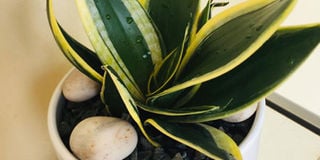Plants that add coziness to your bathroom

Get plants that require minimal sunlight exposure. PHOTOs/Beatrice Nakibuuka.
What you need to know:
The ideal bathroom plant should be able to survive with minimum exposure to light and sun and small enough to fit in the bathrooms.
Some people have always preferred faux plants because all you need is to clean them but living plants do not only give your bathroom a more cozy appearance but also improve your décor style, become pleasant and also improves the quality of air. They also help absorb excess moisture.
Ethel Nambowa, a gardener and landscaper at Green Gardeners in Kasangati, says plants that you choose for the bathroom should be those that survive in places with very little light since bathrooms usually do not have enough access to natural but rely heavily on artificial light.
The plants
Naturally, indoor plants make the best bathroom plants. Most indoor plants do well with limited exposure to sun, light and are compact in size.
Nambowa says, “Bathrooms are usually humid and moist; these conditions favor more tropical plants. However, many people have different tastes and preferences and they may go for flowering plants, water based plants or even ferns.”
Snake plant
Also known as the mother-in-law’s tongue, this plant acts as an air freshener which gives oxygen even at night. It can be put in any part of the house because they prefer indirect but steady light. They can adapt to both full sun conditions and dim situations.
Chinese evergreen
This plant thrives well in moist and humid places like the bathroom. It is very adaptive; prefers low light but also grows well in bright spots and can survive even when you forget to water it.
Lucky bamboo
The lucky bamboo according to Nambowa is a unique and cozy plant that is usually water based. Its shoots come braided or woven in an interesting way. It requires minimal work and can be placed in the corner of your bathroom or near your dressing mirror. You can also look out for other plants that can survive in water.
Ferns
Ferns are another good option for a bathroom plant because they are versatile; moisture-lovers. They give your bathroom a great look once put in a basket and displayed at the windowsill.
Peace Lily
This moisture absorber loves shades and thrives well in humid places which make it a perfect choice for mould prone areas such as the bathroom. It also adds coziness because of its white blossoms.
The plant is good at absorbing moisture through its leaves then the moisture moves down the roots. It does not require direct sunlight to thrive and can grow under minimal lighting. The peace lily is also a perfect choice for people with asthma and allergies since it also purifies air. However, it is toxic to both humans and pets once ingested, it should therefore, be kept away from children and pets.
She says, “The plant produces beautiful flowers but they are toxic to pets so keep it out of reach. Remember to dust or wipe the leaves regularly to ensure they photosynthesize well. If the leaves turn brown it is a sign that the plant needs more watering, a more protected location away from the sun or a supply of manure.”
Other plants can include aloe vera, English Ivy and the money plant. Not all plants enjoy high humidity in the bathroom. Succulents for instance prefer drier conditions and will rot if they are constantly kept moist.
Placement
Where to place your bathroom plant depends on what you really want but you can design a stand and put it on, near the dressing mirror, in the corner or the bathroom window but make sure to avoid getting soap on it.
Care and maintenance
The humidity in the bathroom can always provide a good environment for the survival of the plant but if you have chosen a plant that needs some light, then light is also as important. Ensure that there is some natural lighting through the bathroom window or consider using artificial light.
Joyce Namakula, a homeowner, says bathroom plants are very easy to maintain but should be strategically placed where they will not get into contact with soap or any other laundry detergents because these harm them and may actually wither and die out.
She adds that, “The amount of water your bathroom plant needs depends on the temperature and the amount of sunlight it receives. However, if the soil in the plant feels dry, water the plant until it drips out. I usually water mine once a week.”
Normally, indoor plants are easily attacked by insects and fungal infection because of the coldness according to Nambowa. It is therefore, recommendable to keep cleaning them with clean water and a cotton cloth.
She notes that the basic factors for choosing a bathroom plant should be its tolerance to humidity, amount of light needed and the temperatures a particular plant needs to flourish.
Cost
Ethel Nambowa, a gardener and landscaper at Green Gardeners in Kasangati, says, “The cost of bathroom plants depends on the type of plant you want to buy, the pot used and the size of the plant. If they are in plastic small planters, they can cost Shs15,000 and Shs200,000 if they are in a ceramic planter.”




